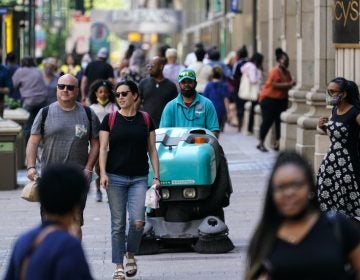From trash to treasure, one Germantown artist’s quest to breathe new life into garbage
I spy a hanger, a helmet, a bottle of shampoo, a feather, a fork, someone’s old shoe, air fresheners, a glove, a discarded CD, a lottery ticket, and a can that had peas.
But we’re not playing in the dump – it’s the Renewed Urban Studio Tent (RUST), one Germantown artist’s attempt to educate participants about the potential magic of the things we throw away, now in residence for the month of August in a gravel lot right across from the Kimmel Center.
Teacher, painter and sculptor Andy Walker, a veteran of public art projects, has always been fascinated by the objects and spaces that society casts aside.
“In the hands of the right person, trash can be art,” Walker said at Friday night’s opening party for RUST, developed and constructed along with Harrisburg-based collaborator Andy Heisey.
RUST, in addition to being an actual temporary artist studio, is a community-decorated sculptural meditation on abandoned buildings and goods. Walker and Heisey were both drawn to art with urban themes and unexpected constructions during their time together in the master’s program at the University of the Arts. When they graduated in 2010 (Walker with a degree in painting, Heisey with a degree in ceramics), they knew they wanted to collaborate on a project.
Through the crowd-funding website Kickstarter, they raised the money for their unique structure earlier this year, and secured a temporary home for it at 313 S. Broad Street, in an empty lot belonging to UArts.
From trash to treasure
Heisey prefabricated the building’s wooden skeleton in Harrisburg. Every piece of wood in the structure is salvaged or recycled, including abandoned wood from the UArts lot, mismatched two-by-fours, and a discarded bed-frame. Disassembled for its recent journey from Harrisburg to Philadelphia, RUST can easily be moved and adapted for placement at difference sites.
For Heisey, the structure’s offbeat parts, once assembled, make for an unexpectedly harmonious product. “The whole thing hangs together,” he said from inside the new studio. “All the strange pieces make a nice whole.”
RUST’s roof is a luxurious green wig of living plants, which help to keep the structure cool for the artists who will be working inside. Natural light comes in through its north-facing side, which is a series of thick window-panes made with layers of colorful kiln-melted glass bottles.
Walker said that the fun of the structure was “making materials do what they’re not supposed to do.”
But RUST’s slag-cement skin was the star of Friday night’s opening. Once the structure itself was installed in late July, Heisey and Walker (operating under the handles Andy #1 and Andy #2, respectively) hosted community participants for the first few days of August, to create the arresting one-man’s-trash collage.
A collaborative effort
About 20 people, including curious tourists, fellow artists, and the local homeless helped to press an eclectic array of found items into shallow pans of cement, which were then dried and assembled as RUST’s outer shell. Many attendees brought their own items to contribute.
Old wrappers, jars and lids joined cigarette butts, a can opener and squashed beer bottles, to name a few more of the items dotting the structure’s exterior. Ceramic tiles covered the studio’s south side, printed with Walker’s photographs of Philadelphia’s abandoned buildings.
Inside the swinging wooden doors, two small desks and a simple easel await about ten artists who, beginning this week, will be in residence there at different times throughout the month of August, including a photographer, a collage-maker, a portrait-painter, and several UArts graduate students. Viewers can visit RUST at its Broad Street location through Aug. 31, and in November, the structure will be re-assembled inside Mt. Airy Art Garage to join a curated show of the RUST artists’ work, some of which will incorporate other discarded objects found on the UArts site.
“There’s nothing perfect when you’re using all these strange materials,” Heisey said. “You have to let them do what they’re going to do.” For Heisey and Walker, the whole project is a reminder that you can never predict just how things will turn out – or where beauty might be found.
WHYY is your source for fact-based, in-depth journalism and information. As a nonprofit organization, we rely on financial support from readers like you. Please give today.















